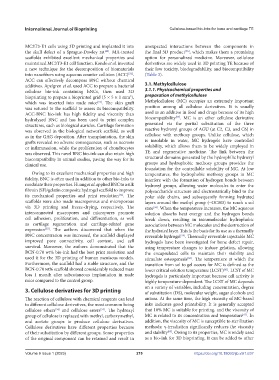Page 227 - IJB-9-1
P. 227
International Journal of Bioprinting Cellulose-based bio-inks for bone and cartilage TE
MC3T3-E1 cells using 3D printing and implanted it into unexpected interactions between the components in
the skull defect of a Sprague-Dawley rat . MA-treated the final 3D product , which makes them a promising
[56]
[49]
scaffolds exhibited excellent mechanical properties and option for personalized medicine. Moreover, cellulose
maintained MC3T3-E1 cell function. Kondo et al. invented derivatives are widely used in 3D printing TE because of
a new technique for the decomposition of biomaterials their low toxicity, biodegradability, and biocompatibility
into nanofibers using aqueous counter collision (ACC) . (Table 3).
[50]
ACC can effectively decompose BNC without chemical
additives. Apelgren et al. used ACC to prepare a bacterial 3.1. Methylcellulose
cellulose bio-ink containing hNCs, then used 3D 3.1.1. Physicochemical properties and
bioprinting to prepare a bioprinted grid (5 × 5 × 1 mm ), preparation of methylcellulose
3
which was inserted into nude mice . The skin graft Methylcellulose (MC) occupies an extremely important
[51]
was sutured to the scaffold to assess its biocompatibility. position among all cellulose derivatives. It is usually
ACC-BNC bio-ink has high fidelity and viscosity than used as an additive in food and drugs because of its high
[57]
hydrolyzed BNC and has been used to print complex biocompatibility . MC is an ether cellulose derivative
structures, such as biological auricles. Cartilage formation generated via the partial substitution of the three
was observed in the biological network scaffold, as well reactive hydroxyl groups of AGU (at C2, C3, and C6) in
as in the GAG deposition. After transplantation, the skin cellulose with methoxy groups. Unlike cellulose, which
grafts revealed no adverse consequences, such as necrosis is insoluble in water, MC hydrogels have controlled
or inflammation, while the proliferation of chondrocytes solubility, which allows them to be widely employed in
was observed. This novel BNC bio-ink can also retain high TE and regenerative medicine. The link between the
biocompatibility in animal studies, paving the way for its structural domains generated by the hydrophilic hydroxyl
clinical use. groups and hydrophobic methoxy groups provides the
foundation for the controllable solubility of MC. At low
Owing to its excellent mechanical properties and high temperatures, the hydrophobic methoxy groups in MC
fidelity, BNC is often used in addition to other bio-inks to interfere with the formation of hydrogen bonds between
modulate their properties. Huang et al. applied BNC to a silk hydroxyl groups, allowing water molecules to enter the
fibroin (SF)/gelatin composite hydrogel scaffold to improve polysaccharide structure and electrostatically bind to the
its mechanical properties and print resolution . The polar side chains, and subsequently forming hydrated
[52]
scaffolds were also made macroporous and microporous layers around the methyl group (–OCH3) to reach a sol
via 3D printing and freeze-drying, respectively. The state . When the temperature increases, the MC aqueous
[58]
interconnected macropores and micropores promote solution absorbs heat energy and the hydrogen bonds
cell adhesion, proliferation, and differentiation, as well break down, resulting in intramolecular hydrophobic
as cartilage regeneration and cartilage-related gene associations between MC molecules and the destruction of
expression . The authors discovered that when the the hydrated layer. This is the basis for its use as a thermally
[53]
BNC concentration was increased, the scaffold displayed reversible hydrogel . Thermally reversible injectable MC
[59]
improved pore connectivity, cell content, and cell hydrogels have been investigated for bone defect repair,
survival. Moreover, the authors demonstrated that the using temperature changes to induce gelation, allowing
BCN-0.70 wt% bio-ink had the best print resolution and the encapsulated cells to maintain their viability and
used it for the 3D printing of human meniscus models. stimulate osteogenesis . The temperature at which the
[60]
Furthermore, the scaffold had a stable structure, and the transition from sol to gel occurs for MC is defined as the
BCN-0.70 wt% scaffold showed considerably reduced mass lower critical solution temperature (LCST) . LCST of MC
[61]
loss 1 month after subcutaneous implantation in nude hydrogels is particularly important because cell activity is
mice compared to the control group. highly temperature-dependent. The LCST of MC depends
on a variety of variables, including concentration, degree
3. Cellulose derivatives for 3D printing of substitution (DS), molecular weight, sugar alcohols and
The reaction of cellulose with chemical reagents can lead anions. At the same time, the high viscosity of MC-based
to different cellulose derivatives, the most common being inks indicates good printability. It is generally accepted
cellulose ethers and cellulose esters . The hydroxyl that 10% MC is suitable for printing, and the viscosity of
[54]
[55]
[62]
group of cellulose is replaced with methyl, carboxymethyl, MC is related to its concentration and temperature . In
and acetate groups to produce cellulose derivatives. addition, the viscosity of MC is susceptible to sterilization
Cellulose derivatives have different properties because methods; γ-irradiation significantly reduces the viscosity
of their substitution by different groups. Some properties and stability . Owing to its properties, MC is widely used
[63]
of the original component can be retained and result in as a bio-ink for 3D bioprinting. It can be added to other
Volume 9 Issue 1 (2023)olume 9 Issue 1 (2023)
V 219 https://doi.org/10.18063/ijb.v9i1.637

